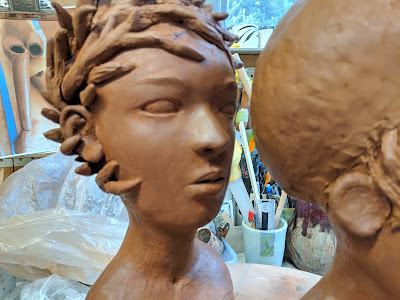Quinces and more Quinces

The quince has a strong apple aroma that's heavenly. The scent filled the house making everyone crazy with thoughts of quince jam and buttery biscuits.
It was time to do a quick stretch and take a good look at the hues and tones. I wanted to record all this quickly, because I really needed to cook that quince!
I started out drawing a quince on tracing paper. This way I could transfer and position the outline onto watercolor paper clearly and cleanly. I quartered a full sheet of hot press 140 lb. paper. I transferred the sketch to two sheets. That way I had two to work on at same time. Quickly I went into that quiet, timeless world.
In the meanwhile, the clay quinces were finished cooking in a sense. They were cooling in the kiln. Out they came---lifeless, drab and yucky pink beige. The clay I use bisque fires to this color, but oh it dresses up right pretty. It takes on terra sig, slips, glazes, washes and anything else you throw at it beautifully so long as you give it the respect that it deserves. The kiln was filled with other lovely things, but those untanned quinces got me all excited! I put aside my watercolors and pulled out my oxide stains, underglazes and glazes.
One of the first things I do with sculptural work fresh out of the kiln is to give them a rutile/frit or a red iron oxide/frit wash. Areas that I need light I sponge away the wash completely. I do like spots here and there, so I will leave those and any scratches, nicks, and nooks. The rutile wash fires to a earthy yellow and adds warmth. The frit, I use Frit 3134 or Gerstley Borate, gives the oxides a little shine, a little twinkle. Next I brush on two coats of white underglaze or slip (formulated for bisque.) It's like gessoeing a canvas. The subsequent paint will clearly show its best hue. Same with underglazes and quinces.
Now there's one layer of wash and two layers of white (dry to the touch.) The quince has shades of green left from its youth. It shines out from underneath the veil of yellow summer sun. It makes sense to put down some bright chartreuse green and let it dry. The next layer is a thin coat of yellow. The green will peek through here and there. It will add dimension and interest.

.jpg) |
| unfinished---needs more work |
Now the quinces are ready to cook!
"The things I like best in T.S. Eliot's poetry, especially in
the Four Quartets, are the semicolons. You cannot hear
them, but they are there, laying out the connections between the
images and the ideas. Sometimes you get a glimpse of a semicolon
coming, a few lines farther on, and it is like climbing a steep
path through woods and seeing a wooden bench just at a bend in
the road ahead, a place where you can expect to sit for a moment,
catching your breath."
Lewis Thomas
from The Medusa and the Snail: More Notes of a Biology
Watcher)

 ,
, 



Love them - your quaint, quintessential quinces! :)
ReplyDeletelove your comment, Vicki :)
DeleteEnjoyed reading the process of the washes and slips and underglazes you use. I'm planning on trying some mason stain mixed with frit for my next firing on greenware and also on bisque to see how they work out but tests will be on ornaments not sculptural work. So this post was very helpful. hope to see your final fired quinces.
ReplyDeleteHello Linda--Hope to see your ornaments and test results, too. The quinces are sitting in the kiln waiting. I'll try to remember to take photos. Sometimes I am in such a hurry to get the fruits shipped out that I forget.
Delete